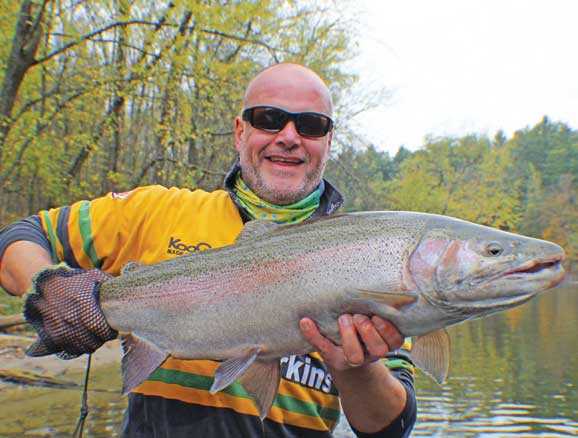West Michigan Rivers that host fall chinook and coho salmon runs, are filling up with some of the largest chinook that we’ve seen in nearly two decades. Right on their tails, literally at times, are fall-run steelhead. The chinook have been testing both angler skill and equipment since their arrival in the rivers and the steelhead will do so through the holiday season. Overall, a very good run so far and we still have a few weeks of salmon movement left on the Muskegon River.
Chinook salmon migration picked up considerably in early October and has been good between Croton Dam and the town of Newaygo itself. A variety of techniques are being used, with both fly gear and spin gear bringing fish to the net. Fly rod weights should be in the 9-10 weight range for salmon and 7-8 weight for fall steelhead. Fly gear options include floating line and indicator rigs, as well as bottom bounce/drift fishing, a.k.a. “chuck-n-duck”. Flies of choice include large nymphs such as Hares Ear, Pheasant Tails, Hex’s, Black Stones, Green Caddis, and Scuds, along with egg patterns in various shades of pastel colors. Spin gear equipment preferences include 9-10′ in length and medium – medium/heavy action. Spin gear rigs include bottom bouncing, as well as bobber rigs much like fly gear floating line setups, as well as casting-retrieving spoons and plugs in the lower river where fresh fish are staging before coming up near spawning grounds.
The chinook are BIG and STRONG this year, so we’ve been using heavier line in general. Both spin and fly gear rigs find 10 and 12 pound tippet being used, as well as heavier 20+ pound mono or braided line for casting-retrieving lures. Most salmon in rivers at this time of the year are in search of spawning grounds. Such habitat on the Muskegon River is most prevalent from Croton Dam down through the town of Newaygo itself.
Fall steelhead are considered by many to be the crown jewel of the Great Lakes due to their speed and epic jumping ability. When in the rivers during the fall months, they aggressively feed on salmon eggs and insects that are kicked up during the salmon spawning process and free floating down the river. Eggs are the highest protein food available to fish and as a result, these fall steelhead are all juiced up and at times are literally uncontrollable! They are present in the Muskegon River from early-mid October through December. Being the southernmost river of the “big 3” (Manistee, PM, and Muskegon), the Muskegon River takes longer to cool down in early fall, but also does not get too cold, too quick and therefore we have good fishing conditions well beyond other rivers.
With last summer and early fall being record drought conditions and then a complete reversal this year with record floods in the spring and cooler than average temperatures in July and early August, who knows exactly how long the “fall” fishing will hold. Safe to say though that based on what I’ve seen over the last 50 days, it should be real good!

[easy-social-share]

